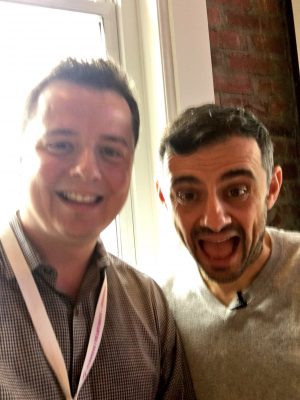Spoken like a true marketer, Gary Vaynerchuk. I recently posted a photo of some Gary Vee sneakers on Instagram, and fellow arts marketer Brenden Guy echoed my love for Gary’s approach and its positive influence on his arts marketing work. We both agreed that Gary’s free content is a goldmine, but doesn’t seem to be as popular with our arts marketing colleagues.
“Arts marketing always seems a little slow to the uptake but I think it’s partly because we’re overworked and underpaid and as a result, we’re pulled in so many different directions,” says Brenden. “It’s really hard to commit to the time required for these sorts of pursuits. But just as Gary will say himself, these are firmly in the excuse column. If you can’t lobby the board, or whoever makes the decisions, to free up your time and resources to spend where the eyes and ears truly are, then it’s time to jump ship otherwise you’ll go down with them. Tradition is revered in the arts world but those who are quicker to adapt will thrive and flourish. It’s no different than any other business.” Don’t you agree?
So, here are the some lessons for arts marketers from us that are inspired by Gary.
- Everything takes longer that you think. Many arts organizations do a decent job programming and planning, but don’t invest the human and financial resources in a longer-term marketing and communications strategy. You can’t start promoting your organization, your brand, or your product a few weeks before an event and not sustain the content 365 days a year. A great example of this approach is extracted from The Cycle: Management of Successful Arts and Cultural Organizations by Michael M. Kaiser and Brett Egan. The marketing component combines brand awareness with targetted messaging and offers some excellent case studies of arts organizations. You can read the book or take the free course on Coursera.
- Stop taking yourself so seriously. In my experience, this is a classic symptom of arts organizations. We want to ascend to a higher level, challenge the status quo and essentially change lives, and the approach is often very serious. This is one of the core reasons why the arts matter, but the content doesn’t always have to be dark, brooding and serious. Check out the Glanmore National Historic Site in Belleville, Ontario, who decided to promote their staff and museum with a video about their love for cats as part of #MuseumDanceOff.
Silliness and fun without being disrespectful can change the way the general public and potentially your target audiences see your organization.
- Where is your underpriced attention? Despite the fact that virtually everyone not only has a Facebook account (79% of Americans use it), and more than half of Americans check it at least several times per day, it can be a challenge to justify paid spends on the platform. With organic reach at less than 3%, you have to pay to play on Facebook. That being said, one radio or TV ad for a week can be thousands of dollars, but you can geotarget potential audiences based on dozens of factors for just dollars per day and track the effectiveness of the post or ad. Why wouldn’t you choose the attention that is less expensive and more effective?
- Documentation of the process is fascinating. A few years ago Gary Vee hired a videographer to follow him around and film everything he does. This content is the basis for Gary’s content including podcasts, video and social posts and is balanced with Gary’s impromptu live sessions from the backs of cars and other unexpected places. The audio and video quality is often mediocre, but the content is like a constant behind the scenes look at his life and work. This type of content is fascinating in arts organizations… how are shows booked, what do dancers eat, how do you curate an exhibition, etc? There is an incredibly opportunity for arts organizations to document what they do all day, every day, and all for the price of someone holding a cell phone. The content doesn’t have to be perfect, so what’s stopping you?
Brenden and I wanted to share some best practices of arts orgs using these lessons, but were having a hard time finding some. Please comment with any links that we can add to this post.
PS. Thanks for the collab, Brendan and for sharing this photo of the two marketing gurus.


Love this post, Julie! Some quality insights for all of us arts marketers to take notice of. Thanks for the collab and including me! 🙂
Author
It’s a pleasure and thank you again. Let’s continue to work together, Brenden.